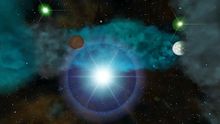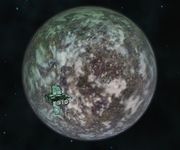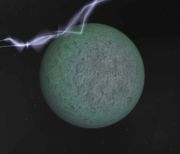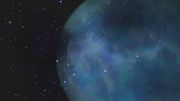Article possibly outdated (v4.86
)This article has not been verified to be up to date for the latest version of the Discovery mod. The last edit was made on 17.12.2012 (
DD/MM/YYYY). You may help by
updating it, often by using the
code generator.
No description available.
System Overview
|
Astronomical Bodies
Stellar Objects
- Medium Blue Sun
- Medium Green Sun
- Green Dwarf Sun
- Planet Nuremberg
- Nordlingen
- Planet Bodensee
- Planet Rosenheim
- Chiemsee Asteroid Field
- Alps Cloud
- Schwarzwald Cloud
|
Industrial Development
|
Faction Presence
Lawful Factions
Corporations & Guilds
Unlawful Factions
|
Jump Gates and Holes
Planetary Bodies
- First charted in 539 A.S., after the discovery of the Munich system in the same year by a Kruger survey vessel, the planet Nuremberg was largely ignored for nearly twenty years, despite a pleasantly temperate climate, with large tracts of plains and savannah that were suitable for farming and settlement. Kruger was instead more interested in the Schwarzwald and Alps clouds, which contained significant amounts of cobalt and silicon, and constructed several small automated mining platforms within the nebulas.
- Location: G/5
- Diameter: 15,029 km.
- Mass: 6.11 x 1024 kg.
- Terrain: Terrestrial
- Temperature: -12°C to 28°C
- Escape Velocity: 12.20 km/sec
|
|
Nordlingen
- A rocky, airless moon of the planet Nuremberg, pock marked with craters. Despite extensive surveys, no significant amounts of any valuable resource have been discovered and it is unlikely that anything will be done with this planetoid beyond the occasional weapons tests done by Daumann and the Rheinland Military on its surface.
- Location: G/5
|
|
Planet Bodensee
- A beautiful gas giant in the Munich system, Bodensee is comprised of over 70% hydrogen and helium, with the remainder of a various number of other gases, but due to the strength of the planet's gravitational pull no attempts have ever been made to use gas miners to retrieve the resources. The swirling clouds of hydrogen and helium in the upper atmosphere of the gas giant are an aesthetically stunning vista that is clearly visible from the viewports of the orbiting Augsburg Colony.
- Location: C/6
|
|
Planet Rosenheim
- Rosenheim is an unremarkable barren world with thin atmosphere and ancient planetary crust devoid of any easily accessible resource deposits. Raubling Station was constructed in the planet's near orbit.
- Location: G/7
- Diameter: 8,409 km
- Mass: 6.22 x 10e24 kg
- Terrain: Barren
- Temperature: -71°C to 24°C
- Escape Velocity: 7.29 km/sec
|
|
Nebula and Asteroids
Chiemsee Asteroid Field
- A mineable asteroid field named after a large German lake, Chiemsee is currently mined by the Daumann Heavy Constructions. Raubling Station was built by Daumann in the vicinity of the field.
- Location: G/6
|
|
Alps Cloud
- A beautiful cloud of green dust and asteroids in the north of the Munich system, the Alps Cloud contains significant amounts of Silicon that Kruger Minerals has mined for centuries, although in recent decades it has suffered considerable setbacks after continual raids on the mining platforms by pirates. Up until a few years ago, Corsairs were often sighted in the cloud and it was believed to be the primary meeting point for the Unioners and Corsairs. Since the ending of the Corsair-Unioner alliance, the Unioners have used the cloud as a hideout to launch attacks against Ingolstadt, and it is believed they have a base located somewhere within its confines.
- Location: F/3
|
|
Schwarzwald Cloud
- A beautiful cloud of green dust and asteroids in the west of the Munich system, the Schwarzwald Cloud contains significant amounts of cobalt that Kruger Minerals has mined for centuries, although in recent decades it has suffered considerable setbacks after continual raids on the mining platforms by pirates. The Unioners and the Bundschuh often frequent the cloud, sometimes launching attacks against Augsburg Orbital Colony. However, the colony is well protected, and the pirates may only succeed in hijacking the occasional trading convoy. The Bundschuh are also believed to have a base in the cloud, although its location is unknown.
- Location: B/4
|
|
Space Stations
- The Augsburg Orbital Colony originally began construction in 781 A.S., but did not finish until 805 A.S., due to a shortage of funding. It was an effort by the Rheinland government to experiment with orbital cities in order to increase available living space without the need for planetary environments. Built around a modular design for easy upgrades, with large food producing biodomes and efficient solar and nuclear powered storage batteries, it is one of the largest space stations ever constructed, with a current population capacity of over a million people.
- Location: C/6
- Class: Space City
- Gravity: Complete
- Docking: Yes
- Amenities: Yes
- Population: 2K
|
|
- The Augsburg Orbital Colony originally began construction in 781 A.S., but did not finish until 805 A.S., due to a shortage of funding. It was an effort by the Rheinland government to experiment with orbital cities in order to increase available living space without the need for planetary environments. Built around a modular design for easy upgrades, with large food producing biodomes and efficient solar and nuclear powered storage batteries, it is one of the largest space stations ever constructed, with a current population capacity of over a million people.
- Location: C/6
- Class: Space City
- Gravity: Complete
- Docking: Yes
- Amenities: Yes
- Population: 2K
|
|
-
- Location: E/6
- Class: Bismarck
- Crew: CLASSIFIED
- Armament: CLASSIFIED
|
|
- Secretly constructed in 762 A.S., Leipheim Base lies in the south eastern reaches of the Alps Cloud. Carved out of a large asteroid within the nebula, the base is home to a large number of Unioners, many of whom prefer the seclusion that Leipheim offers, compared to the more well known Pacifica Base in Bering. Occasionally the LWB are seen at Leipheim, after having made a raid against Nuremberg in order to sabotage the military vehicle production facilities in their never ending efforts to make the Rheinland government use the planet for food production instead.
- Location: F/3
- Class: Messerschmidt
- Gravity: Partial
- Docking: Yes
- Amenities: Yes
- Population: 200
|
|
- Ingolstadt Station was constructed in 730 A.S., a considerable amount of time after the initial colonisation of the planet Nuremberg, in order to handle the ever increasing exports of military vehicles from Nuremberg. Most of the space onboard the station is taken up with secure storage bays for the vehicles, and dozens of ships dock with the orbital facility every day.
- Location: F/5
- Class: Corporate
- Gravity: Complete
- Docking: Yes
- Amenities: Yes
- Population: 500
|
|
-
- Location: B/5
- Class: Wurzburg
- Gravity: Partial
- Docking: Yes
- Amenities: Limited
- Population: 120
|
|
-
- Location: G/7
- Class: Tutzing
- Gravity: Complete
- Docking: Yes
- Amenities: Yes
- Population: 1500
|
|
Mineable Commodities
- Aluminium is a silvery white, ductile metal classed in the boron family of chemical elements. Because aluminium is very chemically reactive, on planets it may only be commonly found combined with any of over 270 other minerals. In space, where Aluminium is formed by the action of gamma rays on lighter atomic elements, the metal may be found in its pure elemental form. Aluminium is very resistant to corrosion and possesses a low density, is nonmagnetic and nonsparking, and is a good thermal and electrical conductor. Aluminium is extremely important in the composition of various alloys essential to transportation, construction, and aerospace applications.
- Location: G/6
|
Error creating thumbnail: Unable to save thumbnail to destination |






